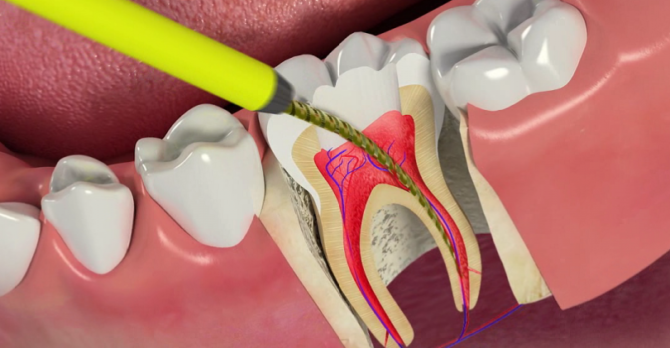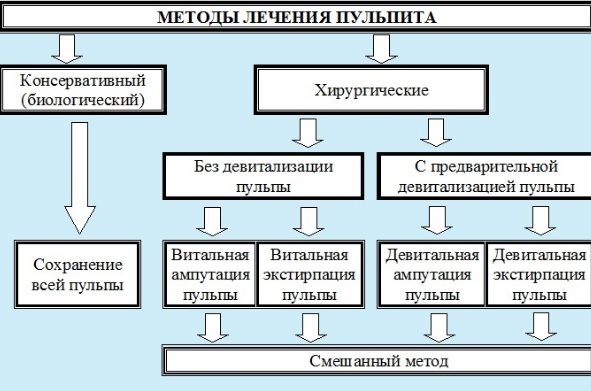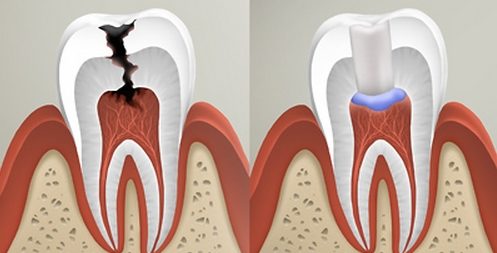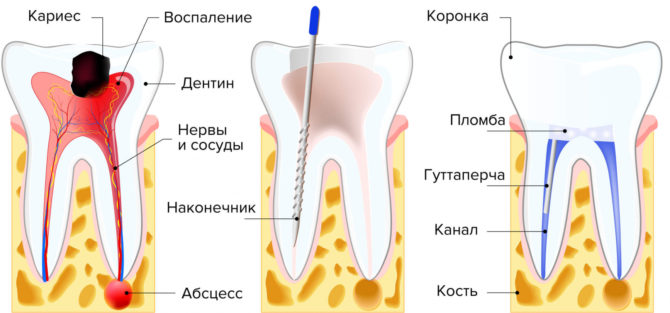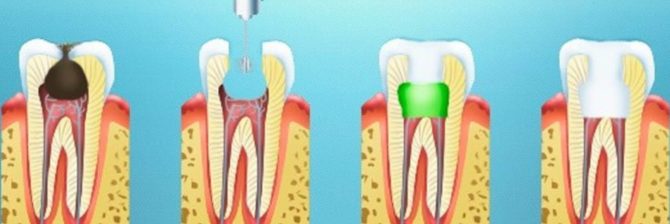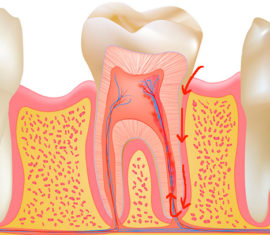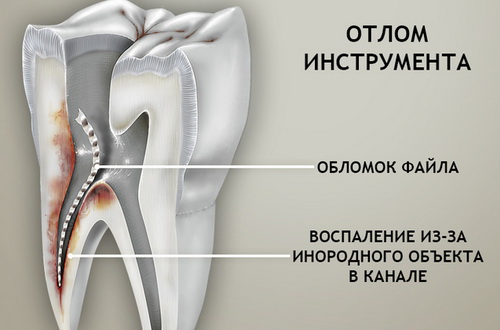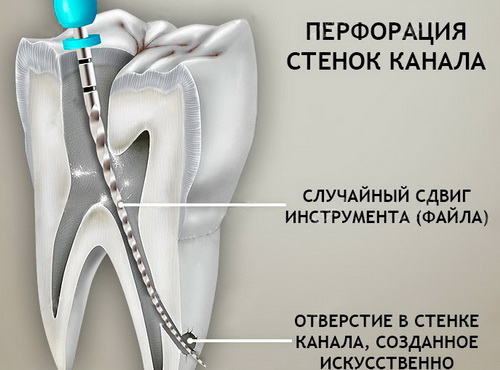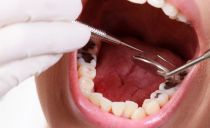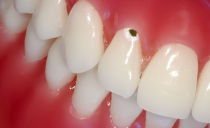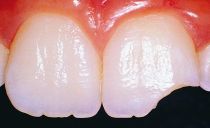Tooth pulpitis: how to cure, methods and stages of treatment, complications, prevention
Superficial carious tooth injuries can develop almost asymptomatically, often patients notice only slightly increased sensitivity to the action of irritants, for example, when consuming sweets. Further spread of the disease deep into the tooth is felt much stronger: when the pulp is damaged, the nerve begins to directly perceive irritation from food or touch. Without treatment, pulpitis of the tooth can cause excruciating pain and cause severe harm to the body.
Content
Why is pulpitis treated?
Any dental disease can lead to serious complications if you ignore its manifestations and do not consult a doctor. The treatment of tooth pulpitis is especially important because this disease affects the internal soft tissues of the tooth located in its pulp chamber. Normally, they provide the innervation and supply of the dental crown and root with all the nutrients, oxygen.
With an infectious-inflammatory process, the pulp becomes a breeding ground for microorganisms that can enter the bloodstream into any internal organ. A constant source of infection can even provoke inflammation of the kidney tissue, although anatomically the kidneys are located far from the diseased tooth. The presence of pathogens in the body causes its weakening, a decrease in immune responses. Highly serious complications of pulpitis are phlegmon, abscesses and blood poisoning.
Pulpitis can also affect the state of the gastrointestinal tract: strong, sharp and long-lasting pain does not interfere with eating and chewing food thoroughly, which may cause digestive problems. Painful sensations distort speech and prevent focus on work or other important matters.
How to cure tooth pulpitis, treatment methods
To get rid of this disease, you need to consult a dentist. At home, you can eliminate the accompanying severe toothache, using improvised means, solutions and lotions, prepared according to popular advice, analgesics. But no independent actions can help cure pulpitis, without the intervention of a doctor, you can only temporarily weaken the symptoms of the disease, which will subsequently return with greater force, because during this time the disease will continue to progress.
The first step in treating pulpitis is to visit a dentist to make a diagnosis and determine an effective treatment method. The choice of a particular treatment technique depends on the age of the patient, the stage of development of the disease. Therapy of acute and chronic pulpitis is carried out in different ways. If the disease has already provoked dangerous consequences, the doctor may remove the tooth. To undergo all the necessary medical procedures, the patient may need several consecutive visits to the doctor.
During therapy and after its completion, the patient must carefully observe oral hygiene so as not to expose the affected tooth to the pathogenic microflora contained in plaque, and to prevent the destruction of healthy teeth.
If the dentist prescribes medication, you should drink them strictly according to the specified scheme.A patient who wants to use folk remedies in addition to the main treatment should ask the doctor what methods of home therapy can be used and which are not.
Biological treatment of pulpitis
This method of treating pulpitis is most favorable for the affected tooth, since its pulp remains alive after treatment. The dentist opens access to the pulp chamber and lays a special antibacterial solution that can destroy the bacterial microflora. The top is covered with a small bandage with calcium hydroxide and a temporary filling. In addition, physiotherapeutic procedures can be prescribed.
After a certain period of treatment, the patient is referred for x-ray to check whether inflammation has been eliminated and whether treatment can be completed. When you visit the pulp again, the tooth opens again. If the dentist is convinced of an improvement in the soft tissue condition, he closes the opening with permanent filling material to prevent re-infection.
With high-quality dental services, this method really helps to preserve the tooth with the least degree of damage. But they use it in rare cases, because:
- Only very experienced dentists in well-equipped clinics can perform all procedures with a minimal risk of complications.
- With advanced forms of pulpitis and in the presence of complications, this method is ineffective.
- In this way, pulpitis is treated only in patients younger than 28 years old.
Treatment in 1 and 2 visits
In the vast majority of cases, pulpitis is treated by extirpation. This method is surgical and involves the complete removal of soft tissue from the pulp chamber. There are two ways to extirpate:
- A vital treatment for pulpitis can be done in one visit to the dentist. The doctor makes an anesthetic injection, cleans hard tissues affected by caries. The cleaned cavity is thoroughly treated with an antiseptic. The dental nerve is completely removed, the root canals and crown are filled. Pulpitis cannot be treated by vital extirpation if the patient suffers from hypersensitivity to anesthetics.
- With the devital method of pulpitis treatment, devitalization is carried out within 2-14 days, so you have to visit the dentist at least two times. At the first visit, the doctor lays a toxic solution of quick or mild exposure in the open cavity of the diseased tooth. In the first case, the pulp dies within 1–2 days, in the second - within 2 weeks. For this period, the hole in the tooth is closed with a temporary filling. After the death of soft tissues, the nerve is removed, and a permanent filling material is laid in the cavity. This method of pulp removal is not used if the patient already develops tissue necrosis, or pus accumulates.
Amputation treatment of pulpitis
During amputation, the dentist can not remove the entire pulp as a whole, but only its affected coronal part. This method is suitable for treating an acute form of the disease or for preventing inflammation in tooth injuries. Pulpitis of teeth having one root is not treated in this way.
The vital amputation method can be used for patients under the age of 45, it requires only one visit to the dentist. The pulpitis treatment process includes the following steps:
- The introduction of anesthesia.
- Cleansing the carious cavity.
- Removal of tissue affected by pulpitis.
- Installation of a permanent seal.
The devital amputation method is used in difficult situations when the dentist cannot get to the desired area of the dental nerve in the curved root canals. Pulpitis treatment can be carried out in 2 visits, the procedure includes the following steps:
- Carious cavity cleansing.
- Devitalization of the affected part of the pulp.
- Removal of devitalized pulp site.
- Mummification of healthy soft tissues with flexible instruments made of titanium or nickel.
- Installation of a permanent seal.
In modern dentistry, mummification using resorcinol-formalin solution is negative. Treated root canals are exposed to very dangerous substances, a red spot appears through the enamel of the crown, and with subsequent problems it is already impossible to cure the tooth.
Sometimes devital amputation is combined with extirpation: in a tooth with several roots, some channels are completely cleaned out, others partially.
Other pulpitis treatments
In addition to surgical methods in which there is an intervention in the structure of the tooth, pulp inflammation helps to eliminate some other modern methods:
-
Laser therapy is a method that allows you to do without the use of a drill and provides faster tissue regeneration while maintaining the viability of the tooth root.
- Physiotherapeutic procedures. They can be used as an addition to surgical techniques, or separately. Contribute to the rapid removal of inflammation and the elimination of pain.
- Depophoresis is a method of treating retrograde pulpitis of a tooth spreading from the root.
Complications in the treatment of pulpitis
Complications can arise not only when the disease is ignored, but also at different stages of pulpitis treatment in dentistry. The most common among them are:
- The irritating effect of drugs used for antiseptic processing, devitalization and mummification on the surrounding tissue of the jaw.
- Damage to the instruments that remove the nerve directly inside the tooth canal.
- Insufficient cleaning of the canal: the doctor does not completely remove the dead or living pulp, blood, particles of hard tissues of the tooth, and they decompose, causing inflammation.
- Insufficient root canal filling: empty space remains from the filled part of the canal to its apex.
- An overly sealed canal: the drug filling the pulp chamber leaves the hole at the top of the root, irritates the jaw tissue and is perceived by the immune system as a foreign body.
- Punching the wall of the root canal with tools to remove tissue affected by pulpitis.
There are times when the drug used to fill the channels of the upper teeth enters the maxillary sinus.
Despite the variety of problems that may arise in the treatment of inflamed pulp, dentistry must be consulted. To reduce the likelihood of such complications, you need to choose conscientious specialists who have high-quality drugs, tools and do the work measuredly, and not serving patients in a hurry.
Prevention of pulpitis and its complications
In the treatment of pulpitis, a nerve is removed, which is involved in the innervation of the entire dentition, so many patients are afraid of these manipulations. The best way to prevent this effect is prevention, which helps to maintain the health of the dentition.
| What do we have to do | What can not be done |
|---|---|
| Eat properly and variably. | Try to remove food debris from the tooth with sharp objects. |
| Time to treat tooth decay. | Combine hot and cold food. |
| Thoroughly and regularly clean the oral cavity from plaque. | Tolerate pain in inflammatory processes. |
| Choose firming toothpastes and brushes with moderately stiff bristles. | Self-medicate with the manifestation of the disease. |
There are many ways in which doctors treat tooth pulpitis, but in each specific situation, the dentist chooses the best method. The sooner the patient turns to the dentist with a complaint of tooth pain, the less pain he will have to endure during treatment and after it. The most effective way to prevent dental diseases is a properly organized prevention.

